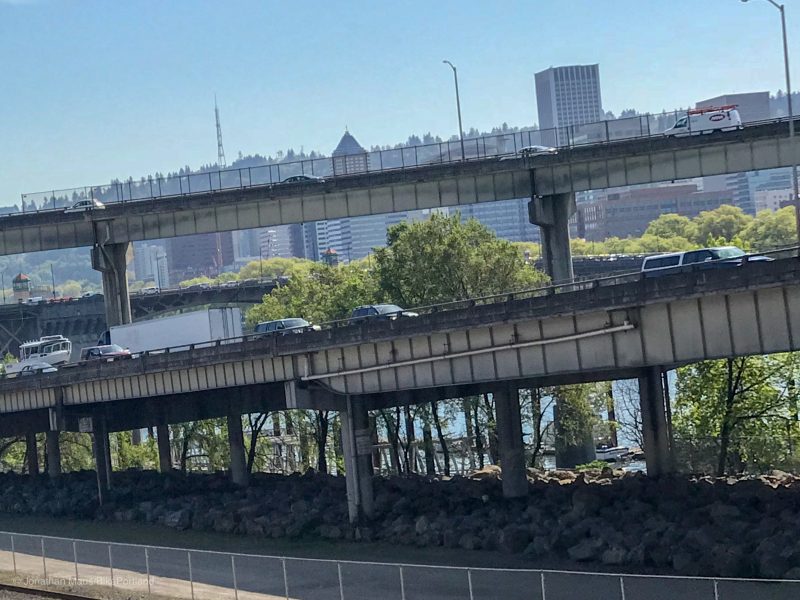
(Photos: Jonathan Maus)
When it comes to transportation, recent statements from Portland Mayor Ted Wheeler paint a confusing picture of the future.
On one hand, Wheeler seems to understand the urgency of climate change. On the other hand, he supports the I-5 Rose Quarter project that adds lanes to a freeway to improve driving conditions in our central city.
On one hand, he understands that the future of transportation is in flux. On the other hand, he supports single-occupancy vehicle use — a form of urban transportation whose time has long since passed.
Confused or simply wrong, Wheeler — someone who is ostensibly a progressive — is on the wrong side of this issue.
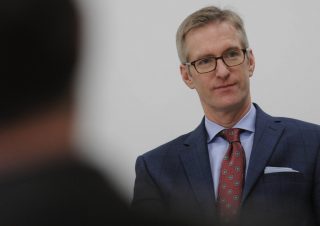
“Cars are ruining our cities,” is the blunt but accurate headline of a New York Times op-ed published this week. It’s an excellent summary of why investing in new freeway lanes — especially in urban areas like Portland’s Rose Quarter — is complete and utter folly.
And that’s just one recent article that demonstrates how the Overton Window on freeway expansion as a salve for congestion is beginning to shift. This is due to many factors, key among them is a growing awareness that the transportation sector continues to hemorrhage greenhouse gases while being largely ignored by politicians — even Democrats like Wheeler.
Last week ClimateWire published an article titled, “Cars threaten climate goals in blue states“, which included this passage: “Liberal states’ carbon-cutting plans are stuck in traffic. Transportation emissions [which are 54 percent of total GHG emissions in Oregon] threaten to undercut blue states’ climate goals, raising questions about their ability to lead U.S. climate efforts at a time when the federal government is rolling back environmental regulations.”
But wait, I’m a “climate change mayor” Wheeler would contend.
To which journalist and activist Alissa Walker would reply, as she did in an article on Curbed.com this month, “You can’t be a ‘climate mayor’ if you’re making more room for cars. Sorry — that’s not how it works.” “If these 402 U.S. mayors are truly adhering to the goals set forth in the Paris climate accord,” she continued, “then none of them can build infrastructure that encourages more emissions by more cars and trucks.”
Advertisement
And don’t let ODOT’s PR spin fool you: The I-5 Rose Quarter project is an attempt to alleviate congestion by adding lanes to a freeway. ODOT can claim it’s about safety and “operational improvements,” but their official infographic on the $5.3 billion transportation plan that includes funding for the project makes it clear: “Relieving congestion bottlenecks will help people get where they want to go quickly and reliably. New lanes on I-5 at the Rose Quarter will save motorists 2.5 million hours wasted in gridlock each year.”
And Wheeler himself doesn’t even try to hide it.
He was asked about the project during an interview on KATU News (Portland ABC affiliate) on April 15th.
KATU reporter:
“As we talk about congested freeways, some would argue against expanding freeways. What would you say to those who say we shouldn’t be adding lanes to area highways?”
Mayor Wheeler:
“Well, you know, highway expansion generally, like building a Mt. Hood freeway, I would agree with them in that case. The lightning rod has really been the work that’s been proposed around the Rose Quarter. That is, two auxiliary lanes that are predominantly going to be built to fix the problem there with the bottleneck. You have several lanes going down to fewer. And you have two ramps coming on, and one going off. So this [project] is going to create auxiliary lanes to help things speed through there a little bit better and actually reduce the number of accidents. So I’m very supportive of that project.”
I’m not sure what’s more disappointing: That Wheeler parrots ODOT talking points and is fooled by the agency’s sly, modern-day tactics to build mega-projects — or the fact that he appears to not understand the connection between investing in urban freeways and increased greenhouse gas emissions, air pollution (Portland ranks 32nd in the nation for worst air pollution), or the role interstate freeways continue to play in the “structured inequality” of our country.
But don’t take it just from climate change experts or journalists. Even Portland-based high-tech CEO Nat Parker is on the opposite side of Wheeler on this issue. “You can’t build your way out of congestion,” the leader of Moovel, an urban mobility company, said in a recap of the TechFestNW event in The Willamette Week earlier this month. “People will drive more if they think there is more room to do so.”
Fortunately there’s a shred of hope. Wheeler is young and seems to be open to change. At a city council meeting on March 15th he shared a version of the future that appeared to look beyond the car-driving status quo:
“I don’t think we know sitting here today what the transportation situation is going to look like even 15 years from now. Those who follow transportation planning believe we are literally right on the edge of a transportation revolution which could shift the demand for parking. It could shift the kind of infrastructure investments we need to make. It could shift the whole question of mobility for people who live with disabilities or older adults. I would be very reluctant to lock ourselves in today. It would sort of be like locking ourselves into an IBM Selectric in 1984.”
(Yes! More of this please! And just FYI, carrying ODOT’s water on a freeway expansion project is the very definition of “locking ourselves in.”)
Unfortunately, that statement came during a presentation about a new master plan for Washington Park. Ironically, Wheeler should take a closer look at that plan for Portland’s marquee park and apply its principles to the central city: Put people and safe, healthy mobility first; push driving to the outskirts; invest in transit and protected bikeways; and create entire areas where there’s no driving allowed at all.
The future of Portland — and to some degree Wheeler’s legacy — depends on building a better city. Not on building a better freeway.
— Jonathan Maus: (503) 706-8804, @jonathan_maus on Twitter and jonathan@bikeportland.org
Never miss a story. Sign-up for the daily BP Headlines email.
BikePortland needs your support.

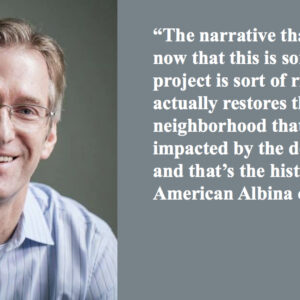
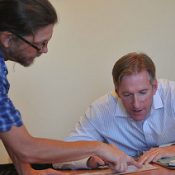
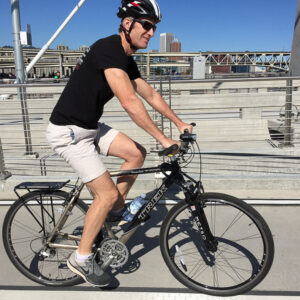
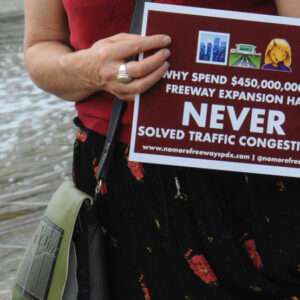
Thanks for reading.
BikePortland has served this community with independent community journalism since 2005. We rely on subscriptions from readers like you to survive. Your financial support is vital in keeping this valuable resource alive and well.
Please subscribe today to strengthen and expand our work.
Wheeler will say he needs to find “balance” to address everyone’s transportation needs, which essentially means that he has no interest in taking on any risk or political heat to correct the backwards priorities of our transportation system.
Wheeler has been a huge disappointment.
Spine, vision, boldness. I’m afraid we’re not going to get it from Wheeler.
“I don’t think we know sitting here today what the transportation situation is going to look like even 15 years from now.”
Actually we know quite a lot, and moreover we know what no-regrets policies would look like. And freeway expansions are the opposite of no-regret strategies. They will soon be recognized as stranded assets: Useless, expensive, unamortizable hunks of concrete, like parking garages.
“Those who follow transportation planning believe we are literally right on the edge of a transportation revolution”
Sure. So American. Let’s wait with baited breath for ‘technology’ to rescue us. Haha.
“It would sort of be like locking ourselves into an IBM Selectric in 1984.”
A miserable if also a frequent analogy. Transportation is nothing like IT. What is this locking in of which Wheeler speaks? Not building the freeway locks us into, what, exactly?
>>> Useless, expensive, unamortizable hunks of concrete, like parking garages. <<<
Parking garages, while expensive, are hardly "unamortizable" — they are actually quite profitable.
They appear profitable at the moment, but it is I think unremarkable to consider a time when they would no longer be, when the demand for the service they provide has dried up and blown away. We don’t know exactly when that time will come, but I’m quite confident that many of us will experience it.
When they are no longer profitable, they will be rebuilt into something that is.
But that is precisely the point. It’s not that easy. Have you tried? Parking garages are basically all inclined planes. One was converted to an airport hotel. It was unbelievably complicated to level everything.
I wouldn’t expect the structure to be reused — the garages would almost certainly be knocked down.
Exactly.
Like he said: unamortizable.
I guess I don’t understand the way you are interpreting that word.
You build something, with the expectation that it will serve its intended purpose for X number of years or decades. Sometimes (nuclear power plant that never went online, highways that were never used, ships that didn’t get pressed into service) pieces of expensive capital are scrapped or lined up in the Arizona desert or anchored in the North Bay. The amortization schedule in those cases didn’t pan out. Someone wrote off a loss.
My point with parking garages of the future and freeway widening in 2018 is that the time will come when we view these investments similarly.
Fine yes. I would answer “most likely already amortized.”
But what got us started is contemplation of building more lanes of freeway. Are you suggesting those have already been amortized/will definitely be amortized?
It’s impossible to say. How do you determine the payback of a freeway lane? When will freeways no longer be needed? When will it need repair/reconstruction? All of these questions have a bearing on the matter, and I don’t know the answer to any of them.
If you assume we are on the verge of collapse of highway-based transportation, they will likely not be “amortized”. If you believe we’re not, then they probably will be.
Wheeler: another failure in a long line of failures to hold the title Mayor of Portland.
I really do think that Mayor Wheeler is well-intentioned and wants to do the right thing.
The problem, as I see it, is that he comes from a well-to-do background and only listens to people from a similar background. He is the most insulated Mayor we’ve had in decades, and he appears unable to see why that might be a problem.
Our City doesn’t work that way. We don’t elect a Mayor to be the “idea guy.” We elect a Mayor to be the one who distills the best ideas from the community and works to build broad political support for them.
If he doesn’t learn to be a better listener and consensus-builder, we could be in for a long, aimless two years.
That’s sort of the problem with Portland politics in general. We end up electing Commissioners from our wealthiest areas, and they listen to people like themselves.
lack of leadership
Excellent op-ed, Jonathan.
“On the other hand, he supports the I-5 Rose Quarter project that adds lanes to a freeway to improve driving conditions in our central city.”
Worth noting: even ODOT itself has commissioned traffic studies which ultimately say this freeway won’t improve driving conditions in the central city.
https://www.portlandmercury.com/news/2018/03/07/19724128/a-new-report-shows-highway-widening-wont-solve-portlands-congestion-woes
ODOT: an agency that does whatever it wants, public priorities, fiscal probity, statistics, logic be damned.
I’m curious about where’s the money coming from for this Rose Quarter thing? Certainly not the Feds. Not the State. It’s broke. So is the City. And if local bonds, how much will be set aside for PERS?
Hi Mike, The funds will be in the form of bonds sold based on revenue to be collected from a host of new taxes passed in the HB 2017 bill. They raised fees on all types of stuff like license, registration, fuel, and so on.
“New lanes on I-5 at the Rose Quarter will save motorists 2.5 million hours wasted in gridlock each year”
While it is true that you can’t build your way out of congestion, bottlenecks that leave vehicles spewing pollutants into the environment while they idle or move inefficiently isn’t exactly helping the environment. Nor is it realistic to think that point to point transportation (i.e. single occupancy vehicles) won’t remain the most relevant form of transport for the foreseeable future. Fixing highly specific/local problems is not the same as trying to pave our way out of problem.
Public transit cannot serve more than a portion of Portland residents’ needs — unless we decide they need to stay home. If every car was taken off the streets so only buses, MAX, etc could operate, it would still be time prohibitive to go to destinations more than a few miles away even presuming you didn’t need to carry much.
Bicycles also cannot be applied as a universal solution. If we accept Google’s estimates as “typical” for a rider, the time issues are similar to public transit.
Bicycles work because they are a particularly efficient form of single occupancy vehicle. As much as I love riding, I can’t say I’ve ever ridden on a city street for any purpose other than to get from point A to point B.
Getting people out of cars requires painting a picture where it makes sense. And that’s going to take more than trying to find ways to make/keep life as miserable as possible for those who aren’t fortunate enough to live close to the center where distances are short, services abundant, and realistic transport options are plentiful.
“Fixing highly specific/local problems is not the same as trying to pave our way out of problem.”
Except that this is not going to fix any problem. It is going to make the problem worse, and use a gargantuan quantity of asphalt and concrete in the process.
“Bicycles also cannot be applied as a universal solution.”
Oh, my. Did anyone suggest it was?
Why run before we’ve even laced up our shoes?
“As much as I love riding, I can’t say I’ve ever ridden on a city street for any purpose other than to get from point A to point B. ”
Non sequitur?
While I do mess up with threading on BP on occasion, you can assume that none of my posts are replies to you unless they contain verbatim quotes and/or are clearly nested under yours with direct reference to the substance of what you say. Don’t expect me to reengage in this thread
But I’ll bite since I’m already here…
We are getting that from the POTUS. Be careful for what you wish for.
I wonder how many people who are so supportive of making auto traffic as difficult as possible walk their talk when it’s not so convenient — i.e. stretch those distances out, reduce/remove bike infrastructure, boost traffic speeds considerably. I’m sure some would, but a lot of what I regularly see given as impediments to riding on this forum is truly mind blowing.
I can’t help but notice that I don’t have to ride out far at all before there’s hardly any cyclists even during peak hours. At night, there’s nothing unusual about riding miles without seeing a single cyclist. I can’t say that about cars…
“I wonder how many people who are so supportive of making auto traffic as difficult as possible walk their talk when it’s not so convenient — i.e. stretch those distances out, reduce/remove bike infrastructure, boost traffic speeds considerably. I’m sure some would, but a lot of what I regularly see given as impediments to riding on this forum is truly mind blowing.”
Hard to follow.
It may also be worth pointing out that there is a world of difference between *not widening roads to ease car-congestion* and what you are suggesting: “make auto traffic as difficult as possible”
Nobody is making travel on I-5 difficult except drivers themselves. Even the merging issues there are just caused by a few drivers who consciously choose to be jerks.
highly specific problems? this is an extremely common problem…
have you watched Hwy 26 west of Portland over the last decade? have you seen how they keep doing a bottleneck congestion improvement every year one exit down from the last one? they’re just widening the freeway the entire length but marketing it as individual safety and congestion projects…
and if you took all the cars off the street it WOULD get easier and faster to get around because another solution for quicker mass transit would have room to develop… it would also force development of smaller dense communities like we used to have that are more self sustaining and don’t require as much commuting…
I started working in Beaverton in 2000. Regular jam-ups around Sylvan to 217 westbound in the early afternoons. They added the 3rd lane soon after, and yes, now 18 years later that third lane has made it to around 185th. Traffic is better NOW (westbound) than it was 18 years ago when I first started out there. So occasionally adding lanes DOES help for significant amount of time. Induced demand is real, but I don’t feel it applies in all situations.
Give it time. The west side is adding tons of new residents constantly, all willing to live further west because of the Hwy 26 improvements. I fell into that trap myself. If you make the commute faster, people will just live further away and ultimately have the same travel time.
I wish there was a movement to remove I-5 completely and return the waterfront to the east side. Maybe that would also help shift the Overton Window for this particular Rose Quarter widening, by seeming so politically impossible that not widening I-5 would seem like a compromise.
The Rose Quarter widening would become unnecessary if I-5 on the east bank were removed. I’d love to see them add more lanes to I-405 and close I-5 on the east bank, but it will be politically impossible until the Marquam eventually needs replacement, or falls down in a Cascadia Subduction earthquake.
405 should also be torn down. Downtown, the Pearl, the Alphabet District, and Goose Hollow should be together again.
agreed! they built 205 to handle all the through I-5 traffic but tons of people still drive right through Portland on the many freeways cutting it apart… shouldn’t they have removed the through freeways inside the city to deter through drivers?
I’d be OK with them just putting a cap over 405 the entire way through Portland so that we don’t have to know it’s there… put a park on top…
Yes and route more traffic and pollution to east PDX residents. No thanks.
Where would you prefer the traffic and pollution be? I’m assuming not your neighborhood. 🙂 I hear Doug’s neighborhood is in need of a freeway, though.
I think 405 is worse than the East bank portion of I-5. 405 from the I-5 split to the Fremont bridge runs through some of the most dense / urban / pedestrian districts in the whole region.
But it would be much easier to cap 405 to restore the grid and mitigate the negative impacts. Trying to bury the east bank freeway would cost billions.
and richest
there was a brief talk about burying I-5 under the eastside esplanade…
This is what I’ve been saying for years now: shift I-5 over to what’s now called 405, and remove the existing I(sore)-5 on the eastside all the way from I-84 to the far end of the Marquam Bridge. The stretch of freeway between the Fremont Bridge and the current west end of I-84 could remain, but would itself become the last (or first) mile of I-84, and would flow just fine without any additional lanes.
I wonder how much a role our peculiar form of city governance (commission-type) plays in insuring Portland has weak and feckless mayors. This in cycle is bound to repeat itself as those attracted to run for mayor are low caliber middle-management types incapable of coalescing consensus or thinking beyond the next election cycle.
We have seen so many ineffective and irrelevant mayors that the truth is now inescapable; Portland needs a reform it’s governance structure. While this is a non-issue when we have uniquely motivated and adept operators like Katz and Goldschmidt holding the office and no urgent matters before us, the recent string of utter failures leads me to believe that it’s the system and not the people elected which is the root of the problem.
Everything from addressing homelessness to transportation reform suffers when we have no leadership and our structure insures these results in perpetuity.
A lot! If we added a City Manager, they’d be able to be the person that implemented cross-Bureau solutions, while the City Mayor could be the politician/idea person. You can’t have one person take on all these roles in a city of Portland’s size.
Jonathan, this is one of the best –and most important– editorials you’ve written yet. THANK YOU. Sometimes it feels like Bikeportland is all we have these days (plus, occasionally, the weeklies).
I kind of like freeways, even though I don’t own a car and get around mostly by walking or biking. Freeways keep the cars safely *out* of my way. I get bothered much more by streets like West Burnside, which put the cars right in my face. No bikelane, a narrow sidelike, just 4 lines of fast moving cars that block me from getting across and make me not want to be anywhere near them.
In the future, educated minds will likely describe this era’s political leaders of Portland as matching well its voting citizens…
I’ve said it before, and I’ll say it again. What ODOT wants, ODOT gets. Traffic is getting worse everywhere. The Bay Bridge in SF westbound is bumper to bumper at 4:30 am (and toll gates don’t help). A widening priject in Seattle on I-5 closed several northbound exits over last weekend, and the backups extended back several miles. In NYC, they’re taking about limiting street parking to NYC residents only. The RQ project won’t improve anything. They tried that in LA, and the result was an epic failure. Our mayor wants bike and ped improvements to wait until the RQ project is finished. Does he realize that we cannot wait that long? Or did someone at ODOT fell him that following ODOT’s lead is the only way to get re-elected?
Great editorial. At this stage of climate change we should be actively tearing out freeways not building more or upgrading the ones we have. But I fear that as a people and a civilization we are too weak to make the hard but necessary choices. This seems to be reflected in our leaders.
Not when you figure in the cost of loss use by people.
I am quite sure the owners do consider alternative uses for their properties, and if a use “by people” were more “amortizable”, they would switch to that use. Though we probably disagree on when and why, 9watts and I both agree conversion is inevitable.
My
Or just close i5 to cars and make it open only to transit and bikes and peds.
I can blow through downtown in minutes at 0400. The issue isn’t capacity, it’s over use at one time.
Yup. Not everyone can change their commute time, but a lot of people can and currently choose not to. They will change when congestion pricing arrives.
You are assuming there are lots of people who have flexible schedules, and are sensitive to price, but not sensitive to being stuck in traffic for 45 minutes. It probably depends on how the pricing is set.
Anecdotally, all of my coworkers have flexible work schedules that allow them to drive at off hours, and 80-90% of them have family situations where they could make it work. They just choose to sleep later.
Of those that are choosing to drive on I5 or I205 during the peak hour, what sort of toll do you think it would take to convince them to wake up earlier? I’m guessing they are reasonably well paid, so it would have to be more than a few dollars. (Many commuters already pay $8 or more each day to park.)
There are commuters in my building who park far away in the neighborhoods or at the Lloyd Center to avoid paying for our patrolled underground building parking, which is just $2.70 per work day in pre-tax payroll deduction. I don’t think the toll would need to be very high to get people to change their drive times.
Maybe we’re different, but in other cities, tolls have sometimes gone very high ($30-$40) to keep congestion down, meaning too many people were getting on the roads when the tolls were $10 or $20, so the price had to keep going up.
I wonder how ODOT would respond to a situation like that. Would they say “congestion pricing is working, you were right, no need for more lanes”, or would they say “we tried it, and it failed. Gentlemen, start your bulldozers!”
I expect ODOT to respond to every situation with proposals for wider roads.
Precisely: do not spend one dime widening freeways prior to implementing congestion pricing. Most likely, the very expensive per mile highway expansion will be unecessary. This is a perfectly feasible (read: not the least bit radicial) position for a Portland Mayor to take.
Hi
Yep , let’s induce more pollution spewing vehicles into the area with wider and faster lanes. Or, simply tax the bottlenecks and provide tree transit.
Toll I-5 at the Columbia River, then see if the RQ congestion is still an issue.
SW Washington US Representatives are riling up constituents by calling any proposed tolls taxation without representation or some such nonsense. it’s easy to write the folks in SW Washington off as entitled suburbanites, and many of them may be. as I understand it, though, any tolling on interstates will need the US Congress’s say so. I don’t know what the answer is to changing minds up there, but it may be a necessary condition. or maybe a few backwards Reps aren’t enough to scuttle tolling. or maybe ODOT will take care of rejecting tolls on its own.
“On the other hand, he supports single-occupancy vehicle use — a form of urban transportation whose time has long since passed.” SO UR SAYIN THAT A BICYCLE WHICH IS A SINGLE OCCUPANCY VEHICLE IS NOT APPROPRIATE IN AN URBAN SETTING? WOW GR8 POINT LOL AUTHOR SOUNDS DELUSIONAL NEXT YER GONNA TELL ME THERES MOAR THAN TWO GENDERS AND 2+2 DONT = 4 AMIRITE?
So well put. Thanks, Fred!
So well put. Thanks, Jonathan!
Lars Larson plant?
The problem w vehicles, airplanes, trains, automobiles, ships, whatever, is that their source of energy is 1) not renewable & 2) releases carbon into the atmosphere. Both of these problems can be solved by synthetic fuels produced from atmospheric carbon using renewable energy. Oil is such a great energy dense source of power that if we didn’t have pools of it in the earth’s crust, we’d have to invent it. There is literally no alternative to oil for flying an air craft due to the liquid phase and energy density. However, biosynthesized fuels solve both of these problems. They consume carbon and use renewable energy via biological catalysts to produce what we have been mining out of the earth for the past century. Given enough industrial scale and effort (otherwise quantified as money) we can actually consume carbon out of the atmosphere and sequester it in the earth’s crust. This gives man kind a thermostat on our atmosphere. This technology is at least a decade old and pilot plants were being established prior to the price of oil collapsing. What is needed is a concerted effort to industrialize this technology. Existing infrastructure for distributing this fuel is sufficient and internal combustion engine efficiencies can further extend its use rather than making vehicles exceeding 1,000 hp which strain modern tire technology to the limits. As far as I can tell, the main problem is that people are simply unaware of this solution so far.
Don’t get me wrong, I’m a huge fan of bicycling. I commute. I ride for fun and it happens to keep me in shape and be good for me as well as give me moments of joy w my kids. But, as far as the big picture, bicycling simply can’t solve our transportation issues. At least not alone but biosynthesized fuels can because 1) they’re not just possible but commercially viable, 2) require no change in the current distribution infrastructure, 3) allow us to maintain current vehicle technology across all modes of transportation and most importantly 4) provide a way out of the current dead end of climate trend.
That sounds very emptying. There is only one problem: energy density, or energy return in energy invested. The stuff in the ground had really high rates of return. The alternatives you’re talking about are much, much lower, and in some cases have negative returns, or we must put more energy in than we get out. We can’t build or maintain the civilization we’ve grown accustomed to on low energy dense fuels. It is impossible.
Tempting, not emptying. D@;n auto-correct.
I kind of liked how you used “emptying” there.
The stuff in the ground doesn’t have the EROI that it used to.
Biosynthesized fuels are net energy positive. These are not to be confused w biodiesel or ethanol, technologies which have dubious EROI’s due to the mechanization of corn harvesting and other inputs.
One of the most promising companies behind this technology was called Joule Unlimited which, unfortunately, shut down last year due to economic and political headwinds. See https://en.wikipedia.org/wiki/Joule_Unlimited
“Biosynthesized fuels are net energy positive”
That really isn’t saying much.
Just saying.
Some of what you envision may be possible Al, reducing the direct energy impact of individual vehicle use, but it doesn’t solve traffic or vehicular-violence problems.
Correct. In fact, the one major drawback of biosynthesized fuels would be that humanity would have the option to kick the can down the road as far as those issues are concerned.
Fossil Fuel was an amazing free gift and Faustian Bargin for Mankind. It represents millions of years of sunlight ( and carbon) collected and stored underground in an easy to use form with high energy density. Our entire technological civilization was built on this cheap and abundant energy. During the peak of Industrial growth the U.S. we could obtain energy in the form of oil with an energy return on energy invested of better than 100 to 1 and in some cases 200 to 1. These cheap ( conventional) sources of oil are rapidly depleting and we are left with Shale, Deep offshore and Tar sands which give us oil at between 10 to 1 and 3 to 1. That is why the oil companies involved in these extractive efforts have no profit and are building up significant unpayable debt. The only thing worse from an EROI standpoint is trying to create oil from scratch using renewable energy which will always be expensive and dispersed over the planet. Trying to hang on to our oil based infrastructure as oil runs out and becomes uneconomic is a fools game. We must be ready to recreate our civilization to reflect the energy sources that we will have availible in the future, not cling to hot rods, drive-ins and commercial air travel.
i expect oil to continue to be cheap due to erosion of demand caused by adoption of renewable energy. a worsening climate catastrophe is inevitable under capitalism, imo.
Or under any economic system assigns a higher value to immediate specific benefits compared with long term abstract costs. Which is almost all of them.
funny how nations with the most extreme capitalist ideology seem to care the least about climate change….
Does the current administration accurately represent how Americans in general think about the issue? And do those who believe climate change is a Chinese plot do so because of “capitalism”?
the usa has been a proponent of extreme laissez faire capitalism for generations. as have australia and to a lesser extent canada.
https://www.statista.com/statistics/478783/leading-countries-based-on-per-capita-greenhouse-gas-emissions/
>>> The only thing worse from an EROI standpoint is trying to create oil from scratch using renewable energy which will always be expensive and dispersed over the planet. <<<
I agree, but if you think of "oil" derived from atmospheric CO2 as an energy carrier (potentially inefficient to make, but easy to handle and having great energy density) rather than an energy source, it makes more sense.
Reducing Vancouver I-5 traffic might not require “congestion pricing”. A pedestrian/autonomous transit bridge from Vancouver to the Expo Center could be cheap AND effective.
The five MAX lines averaged a total of 120,140 weekday passengers in March, with only 12,770 on the Yellow Line and 54,930 on the Blue Line. Some 125,000 vehicles cross the Interstate Bridge daily.
A Bike Tube might siphon off 10-15% of that traffic. It wouldn’t need sophisticated autonomous vehicles and could be a boon for business on both sides of the river. Bechtel’s Airport Max line might be a business model for the Columbia Tube.
http://www.hayden-island.com/columbia-tube/
https://en.wikipedia.org/wiki/Interstate_Bridge
https://trimet.org/about/pdf/2018/2018-03.pdf
https://trimet.org/pdfs/history/railfactsheetairport.pdf
Can we pick and choose our pollution ratings.
I prefer the Lung Associations 153 for annual particle pollution out of 187 metropolitan areas. The 94 ranking for high ozone days out of 227 cities isn’t as good. And then there is the 32nd ranking for 24 hour particle pollution out of 201 metropolitan areas.
Unfortunately we will probably be ranked worse next year for the ’24 hour particle pollution’ because we had several days of smoke from forest fires that blanketed the city. (Looks like rankings were based on 2014, 2015, and 2016 data)
There are a ton of people who all work at Intel or Nike or somewhere in Washington county who choose to drive solo from Vancouver. You like to make excuses for why they cannot carpool or choose to live where the work.